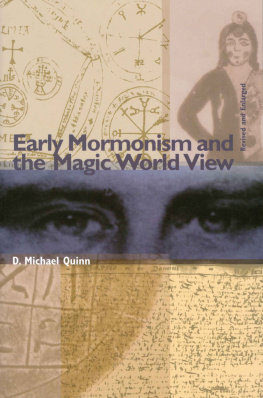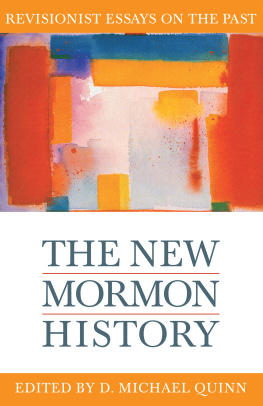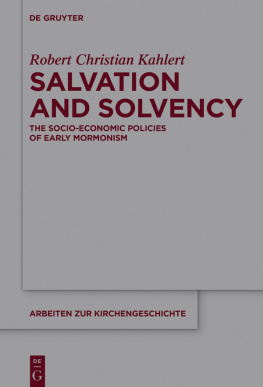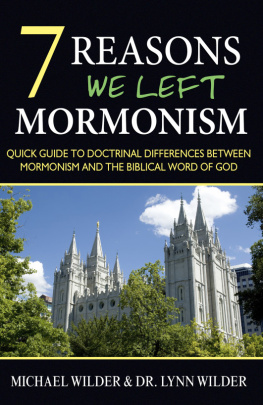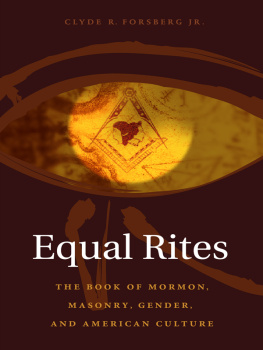Early Mormonism and the Magic World View
Revised and Enlarged
D. Michael Quinn
Signature Books Salt Lake City
1998 Signature Books. All rights reserved.
Signature Books is a registered trademark of Signature Books, Inc.
Preface to the Revised Edition
Shortly after the first printing sold out, I was surprised that Early Mormonism and the Magic World View had become a boon to rare-book dealers. By the 1990s otherwise-poor college students were paying $100 for a battered copy, while avid collectors shelled out $350 for a mint-condition. Having learned this directly from some of the buyers and sellers, I accepted blame for the supply-and-demand problem. Despite brisk sales in 1987-88, I asked the publisher not to reprint until a revised version was ready.
However, I was otherwise preoccupied. There was intensive research/writing of an essay on religion in the American West, a study of current polygamist families, a historical analysis of Mormon women and priesthood, a book on same-sex dynamics in historical and cross-cultural perspective, encyclopedia entries, and two thick volumes describing the hierarchy of the Church of Jesus Christ of Latter-day Saints from the 1830s to 1990s. In the process I worked with editors at Yale University, at Norton, at University of Chicago Press, at University of Illinois Press, at Oxford University Press, and at Signature Books. Overlapping with those activities, I also served as consultant for televised documentaries. After publishing the last volume on the Mormon hierarchy in 1997, I was finally able to revisit the magic world.
Eleven years of escalating publishing costs created another problem. It was impossible to offer even a paperback edition at the 1987 price of the hardback. Therefore, as penance to long-suffering book-buyers, I have reduced my royalties so that this revised edition can be priced as low as possible.
In preparing this eleventh-anniversary revision, my first priority was to include the suggestions of helpful readers. Many disliked the first editions citation-format, which had allowed space to list all cited sources in a bibliography. This edition switches to endnotes, which required dropping a bibliography that had grown to nearly eighty pages due to added research. As advised, I have also streamlined stodgy prose and simplified the analysis where I could. Still, the complexity of some topics requires detailed analysis.
A second goal was to add new information. This revision includes previously overlooked documents and refers to selected sources published during the past eleven years. But readers should not expect the same comprehensiveness for recent publications as the book originally provided for pre-1987 imprints.
My third aim was to respond to critical reviewers. These responses occur from this Preface to the Afterword, often in endnotes and sometimes in the narrative itself. To demonstrate their point of view, I often quote my critics, and each quote reflects the context of their articles or book reviews.
A fourth purpose was to refine the books narrative. Helpful readers and critical reviewers have both noted areas needing attention. This edition corrects previous typographical errors, and I can only hope that multiple proof-reading has not overlooked new ones. The first edition had various statements I have revised, clarified, documented, or corrected. From an eleven-year perspective, I have also modified some interpretations.
Before re-reading the original Introduction for the first time in ten years, I had already decided to preserve its content as an intellectual artifact that readers could compare with my approach in the revised edition. However, in response to reviewers and publications since I987, I have added paragraphs and new citations. I have also refined some phrases for better clarity. Aside from those substantial additions to the Introduction, it maintains the content of the original.
I made those changes in full anticipation that LDS polemicists will attack the slightest variations between the first edition and this revision. A writer in the Foundation for Ancient Research and Mormon Studies (FARMS) recently noted that a detailed review of Quinns Early Mormonism awaits the second edition ... Since Ive introduced the term, I must distinguish between polemicists and apologists.
Not every believer is an apologist, but apologists take special efforts to defend their cherished point of view-whether in religion, science, history, or some other belief/endeavor. It is not an insult to call someone an apologist (which I often do), nor is apologist an unconditional badge of honor. Like drivers on a highway, some apologists are careful, some are careless, some unintentionally injure the innocent, some are Good Samaritans, and a few are sociopaths. Like drivers, even good apologists make errors in judgment and occasionally violate the rules. The same is true for those who dont think theyre apologists.
In a tradition as old as debate, polemics is an extreme version of apologetics. Defending a point of view becomes less important than attacking ones opponents. Aside from their verbal viciousness, polemicists often resort to any method to promote their argument. Polemics intentionally destroys the give-and-take of sincerely respectful disagreement. In the resulting polarization, all are punishd. Moving beyond apologist persuasion, LDS polemicists furiously (and often fraudulently) attack any non-traditional view of Mormonism. They dont mince wordsthey mince the truth.
Unofficially connected for years, Brigham Young University in October I997 announced that FARMS is an official unit of BYU. Daniel C. Peterson, current chairman of FARMS, expressed his first concern about official BYU affiliation: FARMS has often had a polemical edge and we are curious to see how or whether that will be accommodated, he said. The minute I write something offensive, well see if I get a call.
Polemical tactics have been fundamental to the self-definition of FARMS. After six years as book review editor for FARMS, Peterson acknowledged that LDS church members on our side have asked on a number of occasions why do you have to be so polemical, so argumentative? He responded: We did not pick this fight with the Churchs critics, but we will not withdraw from it. I can only regret that some may think less of us for that fact. Then as a religious echo of political McCarthyisms innuendos about its critics, Peterson indicated that Mormons on our side should be careful about criticizing FARMS: Certain of our critics have emphasized our alleged nastiness, I am convinced, as a way of distracting attention from our evidence and arguments.
I realize that by criticizing LDS polemicists, I will be accused of engaging in polemics. This circular trap is inevitable because polemicists alternate between attacking their opponents and claiming victimization by their opponents. I have three responses to the above criticism. First, I have allowed my polemical critics to have their decade, not just their day. Second, I believe this eleventh-anniversary edition responds to these LDS polemicists with greater honesty and civility than they have given me. Third, I avoid what FARMS reviewer William J. Hamblin recently described as whining about the polemical tone of FARMS reviews. He said the real question was whose arguments are superior?a self-description of polemics as personal competition. While I have tried to avoid engaging in polemics, this study does note instances where polemical writings and arguments have been misleading, distorted, or dishonest. Polemicist is a dishonorable vocation, and I use the term only where I believe it applies.
On the other hand, many LDS apologists and defenders avoid polemics, and simply limit research/inquiry within the boundaries of officially approved history. As a consequence, church leaders and well-intentioned apologists often avoid acknowledging the existence of evidence that moves even one step beyond the approved boundary. Because of these various cross-currents, most Mormons now find it easier to suppress their curiosity about the unapproved past.
Next page
